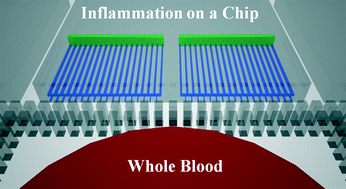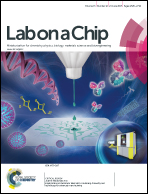Whole blood human neutrophil trafficking in a microfluidic model of infection and inflammation†
Abstract
Appropriate inflammatory responses to wounds and infections require adequate numbers of neutrophils arriving at injury sites. Both insufficient and excessive neutrophil recruitment can be detrimental, favouring systemic spread of microbes or triggering severe tissue damage. Despite its importance in health and disease, the trafficking of neutrophils through tissues remains difficult to control and the mechanisms regulating it are insufficiently understood. These mechanisms are also complex and difficult to isolate using traditional in vivo models. Here we designed a microfluidic model of tissue infection/inflammation, in which human neutrophils emerge from a droplet-size samples of whole blood and display bi-directional traffic between this and micro-chambers containing chemoattractant and microbe-like particles. Two geometrical barriers restrict the entrance of red blood cells from the blood to the micro-chambers and simulate the mechanical function of the endothelial barrier separating the cells in blood from cells in tissues. We found that in the presence of chemoattractant, the number of neutrophils departing the chambers by retrotaxis is in dynamic equilibrium with the neutrophils recruited by chemotaxis. We also found that in the presence of microbe-like particles, the number of neutrophils trapped in the chambers is proportional to the number of particles. Together, the dynamic equilibrium between migration, reversed-migration and trapping processes determine the optimal number of neutrophils at a site. These neutrophils are continuously refreshed and responsive to the number of microbes. Further studies using this infection-inflammation-on-a-chip-model could help study the processes of inflammation resolution. The new in vitro experimental tools may also eventually help testing new therapeutic strategies to limit neutrophil accumulation in tissues during chronic inflammation, without increasing the risk for infections.

- This article is part of the themed collection: Lab on a Chip Pioneers of Miniaturization Lectureship winners


 Please wait while we load your content...
Please wait while we load your content...